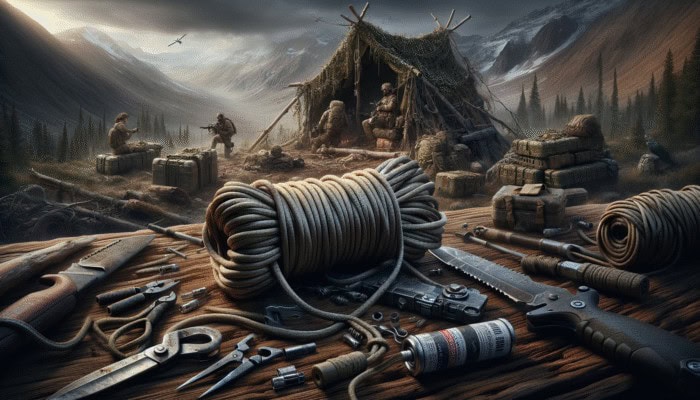Discover the Essential Types of Survival Ropes for Every Adventure
Having the right tools and materials to endure extreme conditions is essential in challenging survival situations. Among these tools, the selection of survival rope types is particularly important as they fulfil diverse roles, ranging from securing equipment to providing critical support that could save a life. Gaining a comprehensive understanding of these various ropes can significantly enhance your preparedness for both outdoor adventures and emergency scenarios.
Maximise Your Gear with Paracord

Paracord, an abbreviation for parachute cord, is widely regarded as an incredibly versatile and indispensable component of any survival kit. Initially developed for military parachutes, its remarkable strength and lightweight characteristics make it suitable for many applications. A standard 550 paracord can handle a tensile strength of up to 550 pounds, making it ideal for various tasks such as constructing shelters, securing gear, or even fashioning makeshift tourniquets during emergencies.
Paracord has demonstrated its extraordinary value in numerous outdoor settings, from the rugged terrains of the Appalachian Trail to the breathtaking landscapes of New Zealand’s Fiordland. Its unique ability to be unwound into multiple strands enables users to fashion fishing lines, shoe laces, or even snares for trapping small animals—skills that can be crucial for survival during dire circumstances.
Paracord's moisture and abrasion resistance also make it an excellent choice for maritime conditions. Whether kayaking through the Amazon Basin or camping by a serene lakeside in Canada, its durability ensures that it remains functional in wet environments, allowing adventurers to rely on it under various conditions.
To enhance the utility of paracord further, consider options like reflective paracord, which is immensely beneficial in low-light situations. The visibility of your rope at night can be vital for safety and rescue efforts, ensuring you can navigate your environment effectively.
Essential Security with Climbing Rope
Among the different survival rope types, climbing ropes are particularly distinguished for their specialised design, which makes them adept at handling substantial loads and dynamic forces. These ropes undergo rigorous testing to ensure they can not only support a climber's weight but also withstand the forces generated during a fall, which is crucial for safety in high-risk environments.
When rappelling down the cliffs of El Capitan in Yosemite or scaling the icy heights of the Andes, climbers require ropes that provide security and flexibility. Typically constructed from nylon, these ropes are designed to stretch, effectively absorbing shock and significantly reducing the likelihood of injury or equipment failure during demanding climbs.
Safety is of the utmost importance when utilising climbing ropes, and comprehending their specific load ratings is essential for effective use. Most climbing ropes measure between 8.5 mm and 11 mm in diameter, with dynamic ropes engineered to stretch. Static ropes provide minimal stretch, making them suitable for hauling gear or executing rescue operations.
For outdoor enthusiasts, selecting the appropriate climbing rope necessitates considering various factors, such as the type of climbing—sport climbing, traditional climbing, or ice climbing—and the environmental conditions. Ropes that resist UV degradation and moisture are fundamental for long-term use, especially in diverse climates like the Mediterranean or tropical rainforests, ensuring reliability and safety throughout your adventures.
Unmatched Durability with Nylon Rope
Nylon rope is synonymous with durability and versatility, making it a fundamental element in numerous survival kits. Its impressive resistance to abrasion and high tensile strength enables it to tackle various tasks, from towing vehicles to securing equipment in unpredictable weather conditions.
Nylon ropes are particularly well-suited for marine applications and exhibit remarkable resistance to saltwater and UV rays. They are extensively used in sailing, fishing, and various water sports, proving essential for activities near coastlines or rivers. Imagine embarking on a sailing adventure in the Caribbean; a reliable nylon rope can secure your boat against the relentless wind and waves, ensuring safety and stability throughout your journey.
Nylon ropes can be employed in wilderness survival situations to construct shelters, secure gear, or even fashion traps. Their minimal stretch makes them ideal for precision-demanding tasks, such as hoisting items or effectively securing climbing gear.
Routine inspection and maintenance of nylon ropes are crucial for their reliability. Be vigilant for signs of wear, such as fraying or discolouration, which may indicate weakening fibres. Proper care extends the lifespan of these ropes, ensuring they remain effective during critical situations when you need them most.
The Critical Importance of Strength and Durability

Strength and durability are paramount in the realm of survival rope types. A rope’s ability to endure various stresses and environmental conditions can decide success or failure in survival scenarios. Understanding these characteristics is essential for making informed choices in critical situations.
Discovering Tensile Strength for Optimal Safety
Grasping the concept of tensile strength is vital when selecting the most suitable rope for specific tasks. Tensile strength is the maximum load a rope can endure before breaking. In survival applications, choosing a rope with the correct tensile strength is crucial for ensuring safety and reliability during use.
For instance, a climbing rope typically possesses a tensile strength of around 5,000 pounds, making it ideal for supporting climbers and heavy loads. Conversely, paracord may only withstand around 550 pounds, which is adequate for tasks like setting up a tent or securing gear but unsuitable for climbing.
Weight is a critical factor in survival scenarios. Carrying a heavy-duty rope may not be feasible in all situations, particularly during extended treks through challenging terrain. Therefore, understanding the tensile strength of various ropes aids in selecting the right one for your needs, ensuring you can carry essential equipment without compromising safety.
Furthermore, tensile strength should not solely be assessed regarding maximum load capacity; it must also be contextualised concerning specific applications. For example, ropes utilised in rescue operations necessitate high tensile strength and the ability to absorb dynamic impacts, making them suitable for sudden loads that may occur during rescues.
Ensuring Longevity with Weather Resistance
Weather resistance is a significant aspect contributing to the longevity and effectiveness of survival ropes. Ropes designed to endure harsh weather conditions, including UV exposure and moisture, are imperative for long-term survival in diverse environments and ensure reliability in various applications.
For example, climbing and sailing often subject ropes to the sun and saltwater, which can degrade fibres over time. Ropes treated with protective coatings or constructed from UV-resistant materials can substantially prolong their lifespan. Such features are vital when navigating challenging routes like the Pacific Crest Trail or engaging in ocean sailing adventures.
In addition to UV resistance, the capacity to repel moisture is critical. Ropes that absorb water can become significantly heavier and lose their strength, rendering them less effective in survival scenarios. Ropes engineered with water-resistant properties, like those used in rafting or coastal activities, provide the reliability necessary in wet conditions, ensuring they perform optimally when needed.
Proper care also enhances weather resistance. Storing ropes in a cool, dry place and avoiding direct sunlight exposure when not in use can prevent premature degradation. Regular inspections can help identify any weaknesses due to environmental exposure, ensuring ropes remain reliable and ready for action.
Maximising Performance with Abrasion Resistance

Abrasion resistance refers to a rope's capability to withstand wear and tear from contact with rough surfaces. This characteristic is crucial for survival ropes that may encounter rocky terrains, rough tree bark, or abrasive surfaces during outdoor activities.
When selecting a survival rope, it's imperative to consider the environments in which it will be utilised. For instance, ropes employed in mountain climbing must possess exceptional abrasion resistance due to the sharp edges found in rocky landscapes. High-quality climbing ropes often incorporate special fibres or protective coatings to enhance their abrasion resistance, ensuring they maintain integrity even under demanding conditions.
A practical application of abrasion-resistant ropes can be observed in rescue situations, where ropes may rub against jagged edges or rough surfaces during extrications. Ropes with enhanced abrasion resistance ensure reliable performance, significantly reducing the risk of sudden failure when lives are at stake.
Regular maintenance can further bolster abrasion resistance. Cleaning ropes after exposure to dirt or contaminants can prevent degradation and extend their usability. Employing proper storage techniques, such as using protective sleeves or storage bags, can also safeguard against unnecessary wear and tear, preserving the performance of survival ropes over time.
Understanding Impact Resistance for Safety
The significance of impact resistance cannot be overstated, particularly in dynamic applications such as climbing or rescue operations. Impact resistance denotes a rope's ability to absorb sudden forces without failing, a critical trait in environments where falls or unexpected loads are possible.
Climbing ropes are specifically engineered to handle dynamic forces, stretching to absorb the energy generated during a fall. This feature safeguards the climber and ensures the safety of the equipment used in high-stress situations. Ropes designed for this purpose are subjected to rigorous testing under stringent conditions, verifying their compliance with safety standards.
Impact resistance plays a vital role in rescue scenarios as well. When rescuers lower individuals or equipment, the sudden load can exert substantial forces on the rope. Ropes designed with high impact resistance mitigate the risks associated with such operations, ensuring that the rescuer and the rescued individuals remain safe throughout the process.
Understanding impact resistance can guide rope selection for outdoor enthusiasts, especially for high-risk activities like bungee jumping or climbing. While it might be tempting to choose lighter ropes for portability, sacrificing impact resistance could lead to catastrophic failures in the event of an unexpected fall.
Critical Chemical Resistance for Hazardous Environments
Chemical resistance is an often-overlooked aspect when discussing survival rope types, yet it is particularly relevant in industrial or emergency settings where exposure to corrosive substances may occur. Ropes that can withstand various chemicals—such as acids, solvents, and oils—are essential for a range of applications, from construction sites to search and rescue operations in hazardous conditions.
For example, nylon and polyester ropes may degrade when exposed to specific chemicals, significantly diminishing their tensile strength. In contrast, ropes constructed from materials like polypropylene or specialised composite fibres offer superior resistance to chemical damage, making them ideal for use in industrial settings where safety is paramount.
In environments where exposure to chemicals is anticipated, understanding the specific resistance capabilities of different rope types becomes crucial. Ropes utilised in chemical plants must be carefully selected to prevent unexpected failures that could result in dangerous situations, ensuring the safety of all personnel involved.
Routine inspections are critical for maintaining the integrity of chemical-resistant ropes. Checking for any signs of degradation or discoloration can help prevent incidents in high-stakes scenarios where rope failure could have catastrophic consequences, ensuring that safety remains a top priority.
Unleashing the Versatility of Survival Ropes
The remarkable versatility of survival rope types significantly enhances their value in emergencies. Ropes that can perform multiple functions enable greater adaptability across varying contexts, making them indispensable tools within any survival kit.
Exploring Multi-functional Applications of Survival Ropes
Ropes' capacity to serve myriad functions makes them an essential component of any survival kit. From securing gear to providing emergency shelter, the applications of survival ropes are virtually limitless, each playing a crucial role in survival scenarios.
For example, paracord can be unwound into several thinner strands, which can be utilised for fishing lines, sewing materials, or even crafting makeshift nets. This multi-functional capability becomes particularly valuable in survival scenarios where every resource must be maximised for various tasks to ensure survival.
When fishing is necessary for sustenance, repurposing a paracord strand as a fishing line can yield food in dire circumstances. Likewise, fashioning traps or snares using rope can significantly enhance the chances of capturing small game, providing essential protein during critical survival.
Furthermore, certain survival ropes can be employed to create emergency stretchers. By using sturdy sticks as supports and wrapping them with robust rope, individuals can transport injured persons efficiently—a skill that can mean the difference between life and death in outdoor adventures or rescue operations.
Enhancing Efficiency with Ease of Knotting
In time-sensitive survival situations, swiftly tying and untying knots can be a game-changing advantage. Ropes facilitating easy knotting can save invaluable time and prevent frustration during emergencies, contributing to overall safety.
Certain rope materials like nylon and paracord allow for smoother knotting and untying, providing users a critical edge during high-pressure moments. Familiarity with the appropriate knots to tie—such as the bowline for securing loads or the clove hitch for attaching to poles—can enhance efficiency in various survival scenarios, ensuring you can act quickly when needed.
Practicing knot-tying techniques can also prove beneficial, especially in high-pressure situations where composure is crucial. Being familiar with essential knots can lead to quicker reactions, ultimately improving the likelihood of success in tasks ranging from building shelters to executing rescues.
Ropes with a smooth texture are often easier to work with, minimising the chances of slipping or tangling. This quality is especially important in survival situations where time is of the essence, as complications arising from tangled ropes can further escalate risks and hinder effective responses.
Length and Weight Considerations for Optimal Portability
Selecting the appropriate length and weight of rope can dramatically impact its portability and utility in the field. In survival scenarios, carrying excessively heavy or long ropes can become burdensome; thus, having the right size can enhance overall manoeuvrability.
Paracord is typically available in various lengths, allowing it to be adaptable for different uses. For instance, a 50-foot length is often sufficient for most outdoor tasks, from securing a tent to creating a makeshift fishing line. The lightweight nature of paracord also facilitates easy transport without significantly adding weight to a backpack.
The weight of gear is a crucial consideration when engaging in long-distance hiking or wilderness expeditions. Opting for lighter ropes while maintaining adequate strength ensures that survival kits remain manageable, allowing for easier movement through challenging terrain and ensuring that you are prepared for unexpected situations.
Understanding the specific needs of your outdoor activities can also guide decisions regarding rope length. For example, climbing expeditions typically require longer ropes than those used for general camping or hiking, where shorter lengths may suffice. This ensures that you are equipped with the right tools for each adventure.
Ensuring Durability and Weather Resistance
Ropes that can withstand harsh conditions and resist degradation significantly enhance their reliability and lifespan in diverse environments. Durability is key in survival situations, as it ensures that ropes continue to perform effectively over time, regardless of the conditions they face.
When ropes are exposed to the elements—be it rain, snow, or intense sunlight—certain materials may degrade over time. Selecting ropes specifically engineered for weather resistance can prevent issues related to moisture absorption or UV damage, thereby guaranteeing they remain functional in various conditions.
For instance, ropes used in marine settings must resist saltwater exposure while also enduring intense UV rays from the sun. Choosing high-quality ropes with protective coatings can significantly extend their usability during outdoor adventures, whether you’re sailing in the Caribbean or hiking through the Swiss Alps.
Properly maintaining ropes by storing them in dry conditions and routinely checking for wear signs can bolster their longevity. Such practices are critical for ensuring that survival ropes are always ready for action when needed, especially in emergencies.
Compatibility with Accessories for Enhanced Functionality
Ropes designed to work seamlessly with accessories such as carabiners, pulleys, and other gear significantly increase their effectiveness in complex survival scenarios. Understanding how to integrate ropes with various accessories effectively can greatly enhance their utility and functionality.
For instance, climbing ropes are commonly used with carabiners for quick attachment and detachment. This compatibility allows for swift adjustments and secure connections, which are crucial in high-pressure scenarios where time is of the essence. The ability to quickly establish a belay system or haul gear can be a game-changing factor in climbing or rescue operations.
Accessories such as pulleys can further enhance the effectiveness of ropes, particularly in situations requiring heavy lifting or lowering. A pulley system can distribute weight more effectively, thereby reducing strain on both the rope and the user, making it essential for transporting cumbersome loads in survival scenarios.
In survival situations, accessories compatible with your rope can simplify tasks and enhance overall efficiency. It is crucial to invest in quality gear and understand how to use it effectively, as this knowledge can mean the difference between success and failure in critical moments when every second counts.
Essential Maintenance and Care for Longevity
Maintaining and caring for survival ropes ensures longevity and reliability during critical situations. Understanding how to care for your ropes can significantly enhance their effectiveness and safety, ensuring they perform when it matters most.
Effective Cleaning Techniques for Rope Preservation
Maintaining clean survival ropes is essential for preserving their structural integrity. Dirt, sand, and other contaminants can gradually wear down the fibres, leading to potential failures when the rope is needed most desperately.
A simple wash with mild soap and water can keep nylon and polyester ropes in optimal condition. Soaking the ropes in warm water and soap, followed by gentle scrubbing, can effectively remove any dirt or grime accumulated during use.
After cleaning, it is crucial to rinse the ropes thoroughly to eliminate any soap residue, which could degrade the fibres if left on. Allowing the ropes to dry completely before storing them is equally essential, as moisture can promote mould growth and weaken the material, compromising their effectiveness.
In situations where ropes have been exposed to harsh chemicals, more specialised cleaning methods may be necessary. Understanding the specific cleaning requirements for different rope materials can help prolong their lifespan and ensure reliability in critical situations.
Optimal Storage Methods for Rope Longevity
How you store your survival ropes can significantly affect their longevity and usability. Improperly stored ropes may become tangled, frayed, or even damaged, compromising their effectiveness when needed.
Consider using a rope bag or a dedicated storage container to prevent tangling. Wrapping ropes neatly and securing them can help maintain their shape and prevent unnecessary wear. It’s advisable to avoid storing ropes in damp or humid conditions, as moisture can lead to rot or mildew, ultimately reducing their lifespan.
For those who frequently trek through diverse environments, it may be beneficial to maintain a small cache of properly stored ropes in their gear. This strategy ensures that they always have access to reliable ropes, regardless of the conditions or tasks they encounter.
It is essential to regularly inspect stored ropes for signs of wear or damage. This proactive practice not only helps to catch potential issues early but also reinforces the importance of keeping gear in peak condition for emergency situations where reliability is paramount.
Thorough Inspection and Timely Replacement
Routine inspection of survival ropes ensures their effectiveness and safety. Checking ropes for signs of wear, such as fraying, discoloration, or cuts, can help identify weaknesses before they lead to failure in critical situations.
Regular inspections—especially after extensive use—allow users to replace damaged or compromised ropes promptly. This practice is particularly important for climbing and rescue ropes, where failure could result in serious injury or loss of life, highlighting the necessity of vigilance.
Adhere to specific guidelines for rope replacement. For example, climbing ropes should be replaced every 3-5 years, depending on usage and maintenance, while utility or general-purpose ropes may last longer but should still be routinely checked for signs of wear.
Investing in high-quality ropes can also reduce the frequency of necessary replacements. Ropes constructed from durable materials designed for specific applications will likely withstand more wear and tear, ultimately extending their usable lifespan and ensuring reliability when it matters most.
Prioritising Safety in Rope Use
Safety is always the top priority in survival scenarios, and understanding the safety considerations related to survival rope types is essential for preventing accidents and ensuring the effective use of equipment during high-risk activities.
Understanding Load Capacity for Enhanced Safety
Grasping a rope's load capacity ensures safety in high-stress situations. Each type of rope possesses a different load rating, and exceeding that limit can lead to catastrophic failures with dire consequences.
For instance, climbing ropes are designed to withstand significant loads and dynamic forces, typically weighing 8,000 and 10,000 pounds. In contrast, utility ropes may have much lower load capacities, rendering them unsuitable for climbing or rescue operations where safety is paramount.
When engaging in activities where load capacity is a concern, such as climbing, rescue, or hauling, selecting ropes specifically designed for those applications is imperative. This selection ensures that the rope can handle the expected load without the risk of failure, safeguarding all individuals involved.
Additionally, it is essential to consider the weight of the individual using the rope and any equipment or gear being supported. This holistic view helps ensure that safety remains paramount in all situations involving ropes, preventing potential accidents and injuries.
Implementing Fall Protection for Safety at Heights
Ropes designed for fall protection are vital for individuals working at heights, including construction workers or climbers. These ropes typically incorporate safety features that help prevent falls and minimise injuries when accidents occur.
Fall protection ropes are often used with harnesses and other safety gear to create secure systems that protect individuals during high-risk activities. Understanding how to set up and utilise these systems properly is critical for ensuring safety in potentially dangerous conditions.
In climbing and rescue scenarios, fall protection ropes are engineered to withstand sudden impacts, stretch to absorb energy, and keep the climber or rescuer safe. Regular fall protection equipment inspections, including ropes, are essential for maintaining safety standards and ensuring that all gear is in top condition.
Training and education regarding the use of fall protection systems are equally important. Familiarity with equipment and techniques reduces the likelihood of accidents and enhances safety during high-risk activities, allowing individuals to navigate challenging environments securely.
Utilising Ropes Effectively in Emergency Situations
Understanding how to use ropes effectively in emergencies can be life-saving. Skills related to knot-tying, securing loads, and creating improvised rescue systems are essential for anyone venturing into remote or challenging environments, enabling prompt and effective responses.
For example, knowing how to create a secure anchor point using a knot can be critical in rescue situations or when securing gear. Ropes can lower individuals to safety, hoist them to higher ground, or create makeshift stretchers for transporting the injured, demonstrating their value in emergencies.
Training in rope rescue techniques can significantly improve outcomes in emergencies. Many outdoor organisations and rescue teams offer courses on these skills, providing valuable knowledge for outdoor enthusiasts, climbers, and emergency responders.
Ultimately, preparedness is key to successfully employing ropes in emergency scenarios. Familiarity with your equipment, practising specific techniques, and understanding the limitations of your ropes can enhance your effectiveness in life-threatening situations, ensuring you are ready to act decisively when needed.
Exploring the World of Specialized Ropes
While many survival ropes serve multi-functional purposes, some are designed for unique applications, enhancing their effectiveness in niche scenarios and addressing specific challenges during emergencies.
The Vital Role of Escape Ropes
Escape ropes are tailored for quick and safe evacuation, making them indispensable in emergencies. Whether escaping from a burning building or a submerged vehicle, these ropes offer a reliable means of egress, allowing individuals to exit hazardous environments swiftly.
Typically lightweight and compact, escape ropes can be easily stored in a backpack or hung strategically for quick access when every second counts. Many escape ropes are designed with a low-visibility colour scheme to avoid detection in sensitive situations, providing a tactical advantage in urban and wilderness environments.
Understanding how to use escape ropes effectively can be the difference between safety and danger. Training in techniques for rapid descent or self-rescue enhances their effectiveness and ensures that users know how to respond quickly during emergencies, increasing their chances of survival.
Maintenance of escape ropes is equally crucial. Regular inspections ensure these ropes remain in peak condition and ready for action when needed, safeguarding individuals during critical moments.
Ensuring Safety with Water Rescue Ropes
Water rescue ropes are specifically designed for aquatic environments, offering buoyancy and resistance to water damage. These ropes are essential for lifeguards, search and rescue teams, and outdoor enthusiasts engaging in water activities, providing reliable tools for saving lives.
Constructed from materials that resist mildew and degradation, water rescue ropes maintain strength and flexibility even in challenging conditions. Their buoyancy allows them to float, making retrieval easier in emergencies where victims may be in the water, enhancing the efficacy of rescue operations.
Understanding the specific requirements of water rescue operations is crucial for practical use. Training in water rescue techniques ensures that those involved can respond quickly and effectively, minimising risks to rescuers and victims, ultimately saving lives during critical situations.
Regular inspections and maintenance help ensure that water rescue ropes remain in optimal condition, ready to assist those in need during emergencies. This reinforces the importance of preparedness in all rescue scenarios.
Conquering Challenges with Ice Climbing Ropes
Ice climbing ropes are specially designed to meet the unique challenges posed by climbing in icy conditions. These ropes provide the necessary grip and strength to navigate vertical ice walls and other frozen terrains, ensuring climbers ascend safely.
Engineered to withstand harsh temperatures, ice climbing ropes feature materials that deliver superior performance in cold environments. Their unique properties help maintain flexibility and strength, even when exposed to freezing temperatures, ensuring reliability during demanding climbs.
Understanding the specific techniques and equipment involved in ice climbing is critical for safety. Training in the proper use of ice climbing ropes can enhance climbers' effectiveness and reduce risks associated with falls or equipment failures, ensuring that climbers are well-prepared for any situation.
Regular inspections of ice climbing ropes are essential, as exposure to sharp ice edges can lead to damage that may not be immediately visible. Ensuring that ropes are in peak condition can significantly improve safety during climbs and enhance overall performance in challenging environments.
Enhancing Functionality with Rope Accessories
In addition to the ropes, various accessories can enhance the functionality and effectiveness of survival rope types. Understanding these accessories can significantly improve your overall capabilities in survival scenarios, enabling you to tackle challenges with greater ease and efficiency.
Utilising Carabiners for Secure Connections
Carabiners are indispensable for connecting ropes to other gear, providing quick attachment and detachment in various situations. These versatile tools come in multiple shapes and sizes, offering different functionalities depending on your application and needs.
When selecting carabiners for survival scenarios, prioritise those with locking mechanisms that prevent accidental opening. This ensures safety during high-stress activities like climbing or rescue operations. The carabiner's strength is also critical; they typically feature rated load capacities ranging from 20 kN to 30 kN or more, making them suitable for various applications.
In climbing, carabiners create secure connections between the climber and the rope. The ability to quickly attach and detach gear can significantly enhance efficiency and safety during climbs, making it essential for outdoor enthusiasts to understand their proper use and functionality.
Regular inspection of carabiners for wear or damage is critical. Ensuring these accessories are in optimal condition can prevent failures during crucial moments, enhancing overall safety in challenging environments and situations where reliability is paramount.
Pulleys: The Key to Easier Load Management
Pulleys are valuable accessories in survival ropes, allowing for easier lifting and lowering of heavy loads. By redirecting the force applied to the rope, pulleys can significantly reduce the effort required to move objects, making them essential in rescue operations or transporting equipment across challenging terrains.
Understanding the mechanics of pulley systems can significantly enhance their effectiveness. For example, utilising multiple pulleys in a system can increase the mechanical advantage, allowing heavier loads to be moved with less force, thereby improving efficiency during critical tasks.
Regular inspection and maintenance of pulleys ensure they remain in optimal working condition. Checking for wear, lubricant levels, and any signs of damage can prevent failures during critical operations, ultimately enhancing overall safety and reliability.
Combining pulleys with ropes effectively can transform the way tasks are approached in survival scenarios. This increases efficiency and reduces the physical demands on individuals, which is particularly important in high-stress situations.
Optimising Performance with Other Essential Gear
Various other gear accessories, such as carabiners and pulleys, can enhance the functionality of survival ropes. These include rope bags, protective sleeves, and storage containers, which can prolong the life of your ropes and ensure their readiness when needed.
Rope bags facilitate easy transport and organisation, helping to reduce the risk of tangling and damage. Protective sleeves can prevent wear from abrasion, especially in high-stress areas, ensuring that your ropes maintain their integrity during demanding situations. Investing in quality storage solutions can significantly enhance the longevity of your ropes, ensuring they remain effective in emergencies.
Integrating these accessories into your survival kit can dramatically improve your overall preparedness. Familiarity with your gear allows for enhanced efficiency and effectiveness in high-pressure scenarios, ultimately increasing your chances of success when facing challenges.
Continue Your Survival Journey with Us
Understanding the various types of ropes available and their specific applications can significantly improve outcomes in survival scenarios. Whether utilising paracord for versatile tasks or selecting specialised ropes for unique conditions, the right equipment can enhance safety and effectiveness in critical situations.
Combining ropes with compatible accessories like carabiners and pulleys increases their utility, allowing for more complex operations and improved resilience. Regular maintenance, inspection, and proper storage can prolong the life of your ropes, ensuring they remain ready for action when needed.
Ultimately, investing in quality survival ropes and accessories and the knowledge to use them effectively can empower individuals to navigate the challenges of the great outdoors and emergencies with confidence and skill.
FAQs: Your Questions Answered
What is paracord, and why is it essential in survival situations?
Paracord, or parachute cord, is a lightweight, versatile rope known for its high tensile strength. It's essential for various survival tasks, such as securing gear, building shelters, and creating emergency tools that can be lifesaving in critical moments.
How do I choose the right climbing rope for my activities?
Choosing the right climbing rope involves considering factors like diameter, length, and type (dynamic vs. static). Assess your climbing style and the specific environment to select a rope that meets safety and performance requirements, ensuring a reliable experience during your climbs.
What is the tensile strength of different types of ropes?
Tensile strength varies by rope type. Climbing ropes typically have strengths of 5,000-10,000 pounds, while paracord generally has around 550 pounds. Always select a rope that exceeds the expected load for your intended activities to ensure safety and reliability.
How should I maintain my survival ropes for optimal performance?
Proper maintenance includes regular cleaning, inspecting for wear or damage, and storing ropes in a cool, dry place. Follow the manufacturer's guidelines for specific care instructions to prolong usability and maintain effectiveness during critical situations.
What are the best knots for survival ropes, and how do I use them?
Some essential knots include the bowline for secure loops, the clove hitch for attaching to objects, and the double fisherman’s knot for joining two ropes. These knots can enhance efficiency and effectiveness during emergencies, allowing for quick and reliable actions.
Why is weather resistance significant for survival ropes?
Weather resistance is vital because ropes exposed to moisture or UV rays can degrade over time. Choosing ropes resistant to these elements ensures they remain functional and reliable in diverse conditions, enhancing your overall preparedness in survival situations.
Can I use regular ropes for climbing, or do I need specialised climbing ropes?
No, regular ropes are not designed for climbing and may lack the necessary safety features. Always use climbing-rated ropes to ensure safety and performance in climbing environments, as this can be the difference between success and failure.
What accessories should I use with survival ropes for enhanced functionality?
Essential accessories include carabiners for connecting gear, pulleys for lifting, and protective sleeves to guard against abrasion. These tools enhance the utility and effectiveness of your ropes, providing additional safety and versatility in various situations.
How do I properly store my survival ropes to ensure their longevity?
Store ropes in a cool, dry place, and avoid exposure to direct sunlight. Use rope bags or containers to prevent tangling and damage, ensuring they are ready for use during emergencies or outdoor adventures.
What makes escape ropes different from regular ropes?
Escape ropes are lightweight and designed for quick evacuation in emergencies. They often feature unique materials and designs prioritising portability and rapid deployment, unlike regular utility ropes, which may not have the same characteristics or intended use.
Explore our journey on X!
SHTF Teamwork Tips: Essential Strategies for Survival
Essential Preparations for SHTF Scenarios Comprehensive Stockpiling of Vital Supplies SHTF Teamwork Tips: In any potential SHTF scenario, the cornerstone of survival is rooted in meticulous planning and preparation. By stockpiling essential supplies, you can ensure that your team is well-equipped to tackle a multitude of challenges that may arise. Concentrate on amassing provisions that […]
Overcoming Survival Doubt: Universal Strategies
Exploring the Concept of Survival Doubt What Is Survival Doubt and How Does It Affect Us? Overcoming Survival Doubt: Survival doubt is a persistent feeling of uncertainty about an individual's ability to navigate the myriad challenges and adversities of life effectively. This sentiment is not confined to any one demographic; it is a universal experience […]
Survival Group Coordination: Essential Strategies
Essential Principles for Coordinating Survival Groups Successfully Why Clear Communication is Crucial for Survival Success Survival Group Coordination: Effective coordination within survival groups relies heavily on the cornerstone of clear communication. When group members can articulate their needs, observations, and decisions with clarity, it fosters an atmosphere where everyone can align and respond effectively to […]
Handling Survival Fear: Universal Strategies
Exploring the Concept of Survival Fear Handling Survival Fear: Survival fear is a fundamental instinct ingrained in human evolution, acting as a vital mechanism for self-preservation. This intense fear arises when individuals perceive threats, whether these are dangerous situations, harsh environments, or personal crises. Throughout history, this instinct has been pivotal in keeping humanity alive, […]








You bring up such an interesting point about the importance of survival ropes, especially paracord. I remember the first time I used a paracord while camping — it was during a sudden downpour, and I had to quickly rig a makeshift tarp. I was amazed at how versatile that rope was, from securing the tarp to helping me set up a camp chair. It really highlighted how much you can do with just one tool.
I really appreciate how you’ve highlighted the importance of various survival ropes, especially paracord. I’ve found that having a solid understanding of these tools has been a game-changer during my own outdoor adventures. I remember a camping trip where my trusty paracord saved the day; it held up a makeshift tarp that kept us dry during an unexpected storm.
I really appreciate how you highlighted the importance of survival ropes like paracord. It’s fascinating how something initially designed for military use has become a staple in outdoor and emergency preparedness gear. Personally, I’ve found paracord to be incredibly useful during camping trips—not just for shelter building but also for tasks like hanging food out of reach from critters or even making improvised dog leashes.